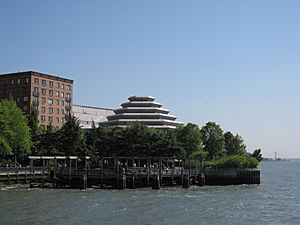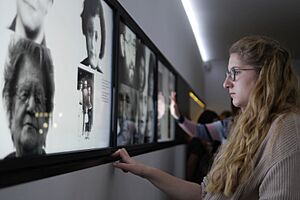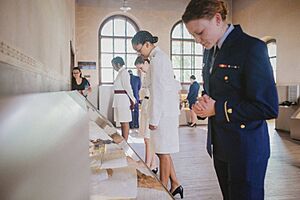Museum of Jewish Heritage facts for kids
 |
|
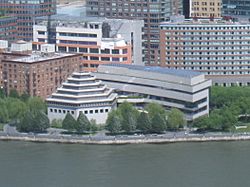
Aerial view of the Museum of Jewish Heritage
|
|
| Established | 1997 |
|---|---|
| Location | Edmond J. Safra Plaza, 36 Battery Place, New York, NY, 10280 |
| Type | Holocaust/Jewish museum |
| Architect | Roche-Dinkeloo |
| Public transit access | Bus: M15, M15 SBS, M20, M55 to South Ferry, M9 to Battery Park City Subway: |
The Museum of Jewish Heritage is a special museum in New York City. It's located in Battery Park City, a neighborhood in Manhattan. This museum helps us remember the millions of people who were killed during The Holocaust.
Since it opened in 1997, over two million people have visited the museum. Its main goal is to teach everyone about Jewish life in the 1900s and 2000s. This includes what Jewish life was like before, during, and after the Holocaust.
The museum building has two main parts, called wings. One wing is six-sided with a pyramid roof. This design reminds us of the six million Jewish people who died in the Holocaust. This part opened in 1997 and holds the museum's main exhibits. The other part is the Robert M. Morgenthau Wing, which opened in 2003. It has offices, a theater, classrooms, and another exhibit space. Both wings were designed by the architects Roche-Dinkeloo.
History of the Museum
The Museum of Jewish Heritage was officially started in 1984. Its building was constructed between 1994 and 1997 in Battery Park City. The museum opened its doors to the public on September 15, 1997. The building cost $21.5 million and was designed by architect Kevin Roche.
David Altshuler was the first director of the museum, serving from 1984 until 1999. Dr. Jud Newborn was the museum's first historian from 1986 to 2000. He helped decide what stories and items would be part of the main exhibits.
For many years, government officials were not very interested in building this museum. But after the Six-Day War in 1967, the American Jewish Community became very interested. Their strong support helped make the museum happen, even though it took a long time.
In 1978, U.S. President Jimmy Carter created a special commission. This group put the idea of a national memorial on the government's to-do list. President Bill Clinton saw this idea become a reality in 1993.
Building the museum faced challenges, including money problems and political discussions. There were debates about where the museum should be located and what it should look like. The museum's location was first planned for the Alexander Hamilton U.S. Custom House. But in 1986, it was moved to Battery Park City.
In 1990, the museum joined with the Center for Holocaust Studies from Brooklyn. Architect Kevin Roche began designing the museum in 1993.
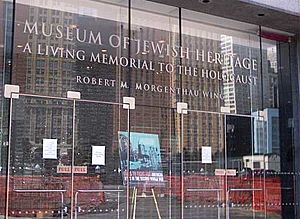
The museum finally opened in 1997 with David Altshuler as its director. David Marwell took over as director in 2000 and helped the museum grow. In 2003, the Robert M. Morgenthau wing was dedicated. This new part added auditoriums, classrooms, a conference center, and space for temporary exhibits.
From 1997 until 2019, the museum had a main exhibit called the Core Exhibition. It told the story of Jewish life in the 1900s and 2000s through objects, photos, and films. This exhibit showed the Holocaust as part of the larger story of modern Jewish history. It was set up on three floors, each covering a different time period: Jewish Life A Century Ago, The War Against the Jews, and Jewish Renewal. This exhibit was in the six-sided building, which represents the six points of the Star of David and the six million Jews killed in the Holocaust.
The main exhibit was updated and reopened in June 2022. The new design changed how visitors learn about the Holocaust. It now focuses more directly on the Holocaust itself, using large photos and fewer objects. A new feature is interactive holograms of Holocaust survivors. These holograms can answer common questions from visitors.
In January 2021, a Confederate flag was found tied to the museum's front door. This happened shortly after the January 6 United States Capitol attack. The police were told about the flag.
Exhibits and Special Displays
The museum has over 30,000 items related to Jewish history and the Holocaust. These items are used in many different exhibits.
Auschwitz. Not long ago. Not far away
This special exhibit opened in May 2019 and was on display until August 30, 2020.
Ordinary Treasures: Highlights From The Museum Of Jewish Heritage Collection
This exhibit shows drawings and everyday items. Many of these were given to the museum by the families of the original owners. The exhibit helps visitors understand what daily life was like for Jewish people in Europe under Nazi rule.
Andy Goldsworthy's Garden of Stones
Andy Goldsworthy created a special outdoor memorial garden called Garden of Stones. It opened in New York City on September 17, 2003. In this garden, trees grow out of large stones. The artist, along with Holocaust survivors and their families, planted the trees. This peaceful garden is meant to be a place for quiet thought. You can see it from almost every floor of the museum.
Gerda III
Gerda III is a Danish rescue boat. In 1943, it helped save Jewish refugees by taking them from Denmark to Sweden. The Danish Parliament gave the boat to the museum in 1997. It is now on loan to Mystic Seaport.
Edmond J. Safra Hall
The Edmond J. Safra Hall is a large room with 375 seats. The museum uses this hall for movies, concerts, and discussions throughout the year. Past events have included talks about the Holocaust, discussions between different religions, and concerts by famous and new artists.
Rendering Witness: Holocaust-Era Art as Testimony
This exhibit shows art made during and right after the Holocaust. The art was created by people who lived through these terrible times, including prisoners in concentration camps. The exhibit helps show the Holocaust as people experienced it then.
Museum Partners
JewishGen
JewishGen is a very popular website for Jewish family history. It offers free access to many Jewish family records online. JewishGen and the museum became partners in 2003. JewishGen has over 22 million records, including family trees, burial records, and Holocaust records. It also has translated books, research tools, and educational classes.
Auschwitz Jewish Center
The museum also works with the Auschwitz Jewish Center in Oświęcim, Poland. This partnership started in 2006.
Before World War II, Oświęcim was a regular Polish town with many Jewish citizens. During the war, the Nazis renamed it Auschwitz and built a terrible concentration camp there. After the war, Auschwitz became a powerful symbol of the Holocaust. In September 2000, the Auschwitz Jewish Center opened. It honors the town's former residents and teaches new generations about what was lost. It is the only Jewish presence left in the town, located very close to Auschwitz-Birkenau.
The Center's goal is to help visitors remember the victims of the Holocaust. It does this by studying the life and culture of the Jewish town that once was. It also offers educational programs that help young people understand the Holocaust's meaning today. The Center has regular exhibits and programs. For example, a program takes cadets and midshipmen from U.S. military academies to Poland. They spend three weeks learning from survivors, experts, and historians.
National Yiddish Theatre Folksbiene
The National Yiddish Theatre Folksbiene is a professional theater company in New York City. It started in 1915. This company performs plays in Yiddish and plays translated into Yiddish. Their theater has screens that show English translations at the same time. The theater company has been based at the Museum of Jewish Heritage since 2016.
See also
- Holocaust memorials (worldwide)
- Jews in New York City
- List of museums and cultural institutions in New York City


